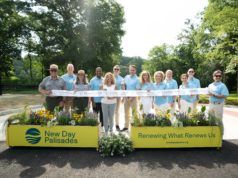
An inside look at the progress of Town Center CID.
By Michael J. Pallerino
If you asked Cobb residents in 1997 to describe Town Center, they might have mentioned a stretch of bustling retail or the traffic bottlenecks along Barrett Parkway. It was a place people passed through — convenient, commercial, and crowded. But beneath the surface, there was potential just waiting to be tapped.
Fast forward nearly three decades and the transformation is undeniable. Today’s Town Center is more than a collection of shops and roadways — it’s a connected, thoughtfully designed community. Greenways and public art have replaced asphalt eyesores. Bikeshare stations, pocket parks, and pedestrian-friendly paths invite people to slow down, stay a while, and engage. And at the heart of that transformation is the Town Center Community, comprised of the Town Center Community Improvement District (CID) and its nonprofit partner, the Town Center Community Alliance.
For the past 28 years, these two organizations have redefined what the district means to Cobb County — investing in mobility, quality of life, and a shared sense of place that didn’t exist before. The story of Town Center is no longer about what it was, but what it has become and most important, what the future holds.
The CID is led by an eight-member board and an expert staff, which includes Executive Director, Tracy Styf; Alisha Smith, Director of Projects and Planning; and Jennifer Hogan, Director of Community Engagement. Smith helps oversee the planning and execution of the CID’s priorities, ensuring each project moves forward with strategic foresight and precision. Hogan plays a major role in shaping the community-facing side of the organization through thoughtful engagement, storytelling, and programming that invites the public into the work.
“Our success comes from the strength of our team,” said Styf. “Everyone brings a different perspective, and that diversity of thought helps us lead with creativity and accountability. Alisha ensures our projects are grounded in strong planning and execution, while Jennifer builds meaningful connections that turn those projects into community assets. Together, we move forward with passion, purpose, and the ability to simply get things done.”
More than just a builder of infrastructure, the Town Center CID continues to be a creator of community. That philosophy has shaped the district’s evolution since its founding in 1997. While the CID remains focused on reducing congestion and improving safety, it also invests in projects that enhance how people experience their environment.
Projects like the Nationally recognized Skip Spann Connector and the South Barrett Reliever (which is scheduled to be completed at the end of this year) are designed to reduce traffic and improve access to key destinations like Kennesaw State University (KSU). While these types of projects continue to be the cornerstone of the CID’s investments, the broader mission in Town Center focuses on how infrastructure serves as the connector of community, leading to improved quality of life, and further investment. Enter the Town Center Community Alliance. Established in 2016, the Alliance serves as the CID’s nonprofit arm, designed to complement traditional infrastructure work through placemaking and quality-of-life initiatives. Styf said the Alliance was created because the infrastructure alone could not capture the full experience of the community. “The Alliance helps us invest in projects that bring people together and create meaningful experiences. The idea for the Alliance came from a simple observation: we saw a greater need to foster connections through creating spaces and places with meaning. We realized that while infrastructure moves people, placemaking moves hearts.”
Styf said that while the CID was doing the hard work of connectivity and safety, it needed a channel to create beauty, engagement, and pride. “The Alliance gives us that and it has changed the relationship with our community. Now, we’re not just seen as builders, but as partners in placemaking and connection.”
The experiences the Town Center Community has been able to deliver are visible across the district. Take Aviation Park. Once an underutilized, kudzu-covered plot of land, it now serves as a vibrant educational and recreational hub. Thanks to the CID’s partnership with KSU, the park features artistic signage, aviation-themed exhibits, and teacher toolkits that make STEM education come alive for students. Families gather for yoga classes under the flight path of Cobb International Airport, and visitors experience a space designed equally for relaxation and learning.
This kind of transformation extends beyond physical improvements — it shapes the emotional connection people have with their community. Public art has become a powerful tool for placemaking. From colorful murals to other art projects, these installations aren’t just decorative — they’re landmarks that foster connection, reflection, and pride. “Our Creative Placemaking Master Plan guides these efforts,” Styf said. “We’re not just filling space — we’re filling needs. Every project is chosen to enhance how people feel and engage when they’re here.”
Building Together
The overall transformation hasn’t been a top-down effort. Community engagement is the foundation of every project in the Town Center Community. In 2024 alone, they hosted more than 20 outreach events, connecting directly with more than 1,200 residents, students, employees, and local businesses. “We don’t see engagement as a box to check — it’s how we do business,” Styf said. “Whether we’re developing a master plan or launching a new program, we listen first and often.”

This feedback loop has shaped initiatives ranging from bikeshare expansion to trail enhancements. This year, the Alliance introduced pedal-assist e-bikes to the bikeshare fleet, making it easier for users of all ages and abilities to explore the district’s growing network of trails and parks.
The focus on active transportation reflects a broader goal: to create healthier, more connected communities. “It’s not just about providing transportation alternatives,” Styf said. “It’s about creating spaces that encourage people to get outside, engage with their environment, and connect with each other.”
Funding for these projects comes through a unique community reinvestment model. Rather than relying on CID tax dollars, the Alliance raises funds through foundation grants, as well as sponsorships and donations from organizations looking to support their initiatives such as Croy Engineering, Kaiser Permanente, REI, Georgia Power Foundation, and the Georgia Department of Education. “Every dollar we raise goes right back into the community,” Styf said. “It’s a true partnership model that allows us to deliver projects with lasting value.”
These projects are also investments in economic vitality. Walkable, vibrant communities attract talent and support local businesses. As the district continues to grow, new development is increasingly centered on pedestrian-friendly design and access to greenspace.
Connecting the Dots
At the center of this transformation is Styf, who has spent the past decade guiding the CID and Alliance with a clear vision and collaborative leadership style. Her approach blends big-picture thinking with a relentless focus on execution. More than anything has been her belief that success isn’t just about finishing a project, but instead is grounded in building trust and partnerships that foster the long-term impact created.
Under her leadership, the CID has secured more than $130 million in grant funding and leveraged over $210 million in additional investment. These funds have supported everything from major roadway improvements to community-focused projects that improve daily life for residents and visitors alike.
Styf also understands that leadership means ensuring the district is prepared for what is next. The CID’s Comprehensive Master Plan and first Strategic Plan, both developed under her leadership, have created a roadmap for sustainable growth. Together, these plans identified $168 million in long-term priorities and set the stage for the district’s continued evolution. “Our success has always been built on collaboration. The relationships we’ve developed over the years — with local businesses, state agencies, and community members — are the reason we’re able to keep delivering projects that matter.”
The Road Ahead
The Town Center Community is preparing for an ambitious future. One of the signature initiatives is the Loop Project, a seven-mile multimodal corridor that will connect key destinations and encourage redevelopment throughout the district.

Also on the horizon is the Noonday Creek Trail Pedestrian Bridge, which is a central connection point that will link more than 22 miles of trails across Cobb County. This critical connection is expected to break ground in 2027 and serve as a new gateway for residents and visitors to explore the region. Public art also remains a priority. Plans are underway for three new installations in the coming months that will engage people of all ages and backgrounds.
For Styf, this next chapter is about deepening the district’s identity as a place where infrastructure supports not just mobility, but meaningful community experiences. “The future of Town Center isn’t just about accommodating growth — it’s about shaping it,” Styf said. “We’re creating a place where people don’t just pass through. They stay, connect, and take pride in being part of something special.”
In recent years, the Town Center CID and Alliance have redefined what’s possible when strategic planning, public-private partnerships, and community engagement come together. Their work has transformed a once-commuter-heavy corridor into a vibrant, people-centered community (see sidebar, “Legacy in Motion”).
As Cobb County continues to grow and evolve, the Town Center Community stands ready to lead. Their focus on innovation, inclusion, and long-term impact ensures that Town Center’s next decade will be just as transformative as the last. “Success today is measured in outcomes and experiences,” Styf said. “It’s delivering an impact people can see and feel, like new options to avoid traffic on Barrett Parkway, safe and vibrant trails, more green space, and public art that brings people together. Beyond physical impact, success today also means being a trusted, dependable partner. Our ability to deliver and lead projects from concept to completion with integrity, transparency, and consistency is what builds confidence in our work. This opens doors for future collaboration and funding, and that’s what sustains us long-term.”
As the Town Center Community moves into their next chapter, the focus remains on building not just for today, but for the generations to come. With every mile of trail extended, every piece of public art unveiled, and every partnership forged, they are shaping a district that balances growth with connection, innovation with tradition, and progress with a deep sense of place. The work is far from finished — but in many ways, that’s the most exciting part.
The best chapters of Town Center’s story are still being written.
BY THE NUMBERS – INSIDE THE CID
- $12.6 billion in annual economic impact to Cobb County
- $238.5 million in public revenue generated each year
- 35,765 jobs supported within the district
- $210 million-plus in additional leveraged funds
- Over 100,000 bikeshare rides since program launch
- 20-plus community events in 2024 alone
LEGACY IN MOTION
Over the past decade, the Town Center CID and Alliance has delivered transformative infrastructure, community-focused projects, and a blueprint for what partnership can achieve. Its signature accomplishments include:
Skip Spann Connector – A nationally recognized project that transformed congestion and campus access.
South Barrett Reliever – The district’s largest project to date, expected to reduce Barrett Parkway traffic by 22 percent.
Big Shanty Road Widening – Easing commutes and improving roadway safety.
Electric Vehicle Charging Study & Freight Plan – Positioning the district for smarter, more sustainable transportation.
Aviation Park – A fusion of greenspace, education, and recreation.
Public Art & Placemaking – Including Cobb County’s first bridge mural and a USA Track & Field-certified race along Noonday Creek.
Master & Strategic Planning – A data-driven roadmap ensuring the CID and Alliance remain aligned and future-ready.



